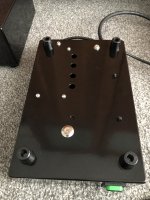PA3s owners, the main heating in this amplifier at low-average power is dropout dissipation on 5v regulator from 26V input voltage. It heats like iron.
Propably this can be at many other boards, with only one power supply voltage...
Propably this can be at many other boards, with only one power supply voltage...
If amp is lowish in input impedance and balanced inputs are used care myst be taken to maintain the common mode rejection.Particularly the tiny 2.5 mm pitched 1 uF MKS are nice.
20% caps and f-3 near 20 hz may affect common mode 50 Hz rejection.
Then its better with a normal 47uf to 220uf cap
Long wires are antennas. The ceramic caps originally used probably have about the same tolerance.
Boards use either use a linear regulator that indeed becomes hot or a switcher that stays cooler (but has higher noise). This can all be done more optimal by using a linear transformer based PSU with a separate 7V winding or a separate small 7V transformer.PA3s owners, the main heating in this amplifier at low-average power is dropout dissipation on 5v regulator from 26V input voltage. It heats like iron.
Propably this can be at many other boards, with only one power supply voltage...
If the f-3 frequency is low enough the tolerance does not matter. But for low CMR often 0.1% resistors are used. So not much room for difference in freq response.The ceramic caps originally used probably have about the same tolerance.
I'm talking about realisation by chineese engineers by fact...Boards use either use a linear regulator that indeed becomes hot or a switcher that stays cooler (but has higher noise). This can all be done more optimal by using a linear transformer based PSU with a separate 7V winding or a separate small 7V transformer.
Btw, any thoughts about trying D class with linear power supply ?
On the poard with the yellow RCA and copper coils + dual ma12070, vol + LF/HF adjustment, the voltage before the 7805 is 12 Volts.Propably this can be at many other boards, with only one power supply voltage...
That 12 volt go also to ne5532 opamps. They have 6 volts DC out. That 6V DC goes to blocking caps. It is 1.4 Volts DC on ma12070signal inputs.
To me it looks like the ma12070 is only driven on one input. So no differential. Thats a pity. I would also prefer diff. But I need the volume pot.
YES...To me it looks like the ma12070 is only driven on one input. So no differential. Thats a pity
That's why you have to remove the input resistors...And wire them symmetrically...
You absolutely have to bypass the input stage!👍
It would have been surprising if with RCA inputs... that the amp was driven in balanced mode... 😂
Unlike the tpa chip, there is no OP amp systematically to balance the signal.
The MA chip seems to adapt if in- is to ground = unbalanced mode.
Last edited:
Yes but since there is 1.4V DC on the inputs of the chips, they can't be grounded. (on this amp) There must be a cap and prefferably a resistor in series between in- and ground.
I measured the gain of the preamp and amp.
Input 0.176V V
Out first amp 0.065 V
Out second amp, 0,76 V
Out third amp 0.76 V
Out MA 7.6 V
So summing in first amp to sub.
12 dB gain in preamps
20 dB gain in MA
Guess you get 26 dB gain driven balanced, but also 3 dB more output noice. (If source are main noise source)
I measured the gain of the preamp and amp.
Input 0.176V V
Out first amp 0.065 V
Out second amp, 0,76 V
Out third amp 0.76 V
Out MA 7.6 V
So summing in first amp to sub.
12 dB gain in preamps
20 dB gain in MA
Guess you get 26 dB gain driven balanced, but also 3 dB more output noice. (If source are main noise source)
Yes, since the opamps have tone control circuits and not single ended to balanced circuits. (Which is possibe with 2 opamps each channel)It would have been surprising if with RCA inputs... that the amp was driven in balanced mode... 😂
But if the user need 32 dB gain and only has single ended source, the amp is "perfect". A signal directly from laptop PC or phone comes to mind.
I am quite impressed that the amp is quiet with 90 dB speaker (tested) and 32 dB gain
I am quite impressed that the amp is quiet with 90 dB speaker (tested) and 32 dB gain
Thanks for the info!Yes but since there is 1.4V DC on the inputs of the chips
I didn't take the time to take measurements...A 30 euro board is either make or break....
On this board, just keep what's necessary 🙂
And yes, but... It's even better by driving the chip symmetrically from A to Z.I am quite impressed that the amp is quiet with 90 dB speaker (tested) and 32 dB gain
Would like to see some measurements. Of course I agree that there are less noise with 26dB gain than 32 dB gain. But is it also less distortion?
Lokking at the documentation somewhere there has to be done some balancing if all the bridges in the chip is used in single ended mode

Lokking at the documentation somewhere there has to be done some balancing if all the bridges in the chip is used in single ended mode
Yes, the MSEL pins configure the output stage.Hmm, are we really sure OUT1 is used if IN0B, IN1A, IN1B has no signal?
- Home
- Amplifiers
- Class D
- Infineon MA12070 Class D

